Raymarine Ray90, a full featured black box VHF radio with wireless handsets and Bluetooth audio
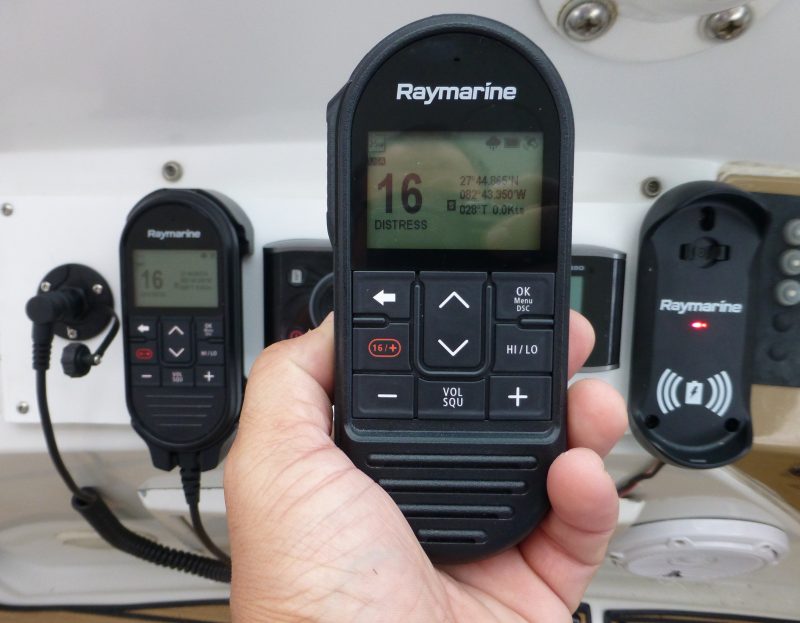
Ray90 wireless handset in my hand with the wired handset on the left and the cradle for the wireless on the right
I believe that VHF radios from the big four MFD manufacturers are primarily offered so that boat builders and customers can put a single brand of electronics at the helm, and thus my normal advice is to consider VHF radios (and AIS transponders) from specialist manufacturers who may offer fuller-featured, better-performing equipment. Testing the new Raymarine Ray90 makes me reconsider that recommendation. The 90 is a compelling VHF regardless of your brand of MFD, plus I discovered an intereresting Bluetooth feature.
The $950 list price Ray90 and its $1,050 Ray91 sibling are identical except for the addition of an AIS receiver to the Ray91. Both are black box DSC VHF radios, meaning the only portion visible at the helm are the handsets and optional speakers. The base unit supports two wired handsets (via the HS1 and HS2 ports pictured above), and up to three wireless handsets that connect via 2.4ghz WiFi to a separate wired Hub (which thus can be installed in an optimal wireless location). The Ray90/91 also include hailer functionality with listen-back as well as integrated GPS, which means that the VHF DSC distress call feature is fully functional ever if the included NMEA 2000 or NMEA 0183 communications are not in use.
The black box architecture allows the Ray90 to serve two helms, and roaming crew, though the handset and optional speaker consume little helm space. These radios also allow separate power control of each handset, which I appreciate with family aboard. Have Another Day previously had a fixed mount VHF with a second station mic at the lower helm, and with power only controlled for the whole radio, it was all stations on or all off.
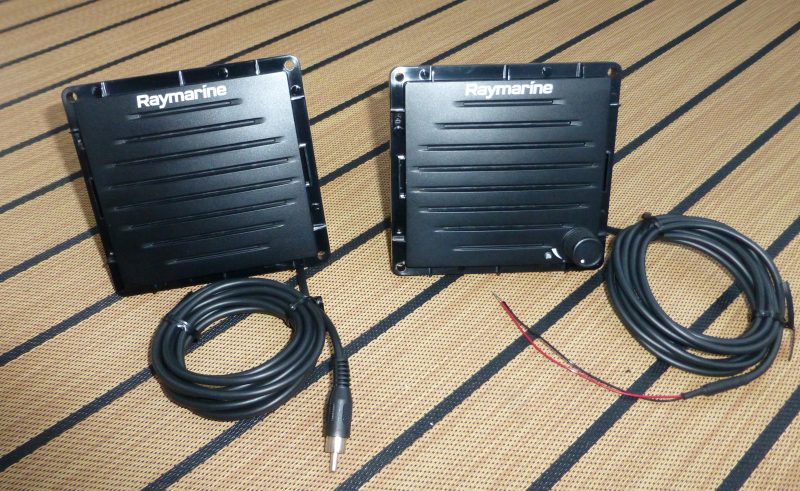
A passive speaker on the left with its RCA audio input and the wireless active speaker on the right with its 12v input
Raymarine has taken a different approach to external speakers for the Ray90 and Ray91. When using a wired handset a passive speaker is used. This speaker connects to the handset cable via an RCA style connection. The wireless handsets use an active, meaning it has its own amplifier, wireless speaker that connects to the wireless handset via Bluetooth. A little more about that later.
Installation and setup
Installation of the radio is straightforward. Once the necessary connections for power, VHF antenna, and at least one handset have been made the radio powers up, asks for an MMSI and is ready to go. If you’re connecting wireless handsets you will need to configure or confirm the default settings for SSID (wireless network name) and WiFi password. That information is then input into the wireless handsets after which they will connect and also be ready for action.
- The home screen
- Menus allow additional functionality and configuration
- Submenus where configuration changes are made
I found the menus easy to navigate, the setting options easy to understand and the handsets quite responsive. The Ray90 handsets have relatively few buttons so most functions are accessed through the menu system. This includes some functions, like weather, that you might find dedicated buttons for on a fixed mount radio with more space for controls. With the Ray90’s straightforward menus it was easy to find everything but several button presses are required for most functions. Incidentally, the radios support scanning all channels or scanning a saved list of favorites, and each mode can be scanned with or without 16 as a priority channel.
DSC calling
I found DSC support between the Ray90 and my Axiom MFDs worked well. I was able to request a position from another DSC radio and immediately upon reply the above message popped up on my Axioms (though the Buddy name I’d assigned to that MMSI on the Ray90 wasn’t displayed on the Axiom). I tried the same test on both my Garmin and Simrad MFDs with mixed results. I eventually found a position report in the DSC log on the Garmin 1242XSV Touch but never could find anything on the Simrad NSS EVO3. I suspect few people use position request and sharing capabilities (and find Ben E’s words from 2006 about complexity still very applicable) but NMEA-2000 connectivity does make the connections more straightforward and allow tracking other radios like on buddy boats and dinghies.
Wireless handsets
- The front of the wireless handset
- The back of the wireless handset
- The cradle and wireless charger for the wireless handset
- The wireless hub that connects wireless handsets to the base unit via WiFi
- When the handset powers on it connects to the wireless hub
- And confirms the connection in a couple of seconds
The wireless handset set the Ray90 apart from other radios I’ve used and tested. The Ray90/91 modular radios joins the Standard Horizon GX6000 the Ben E is testing as the only marine VHFs I’m aware of to utilize WiFi for wireless handset support. I’m a fan of reusing a well established and engineered standard for wireless, and while I have some concerns about the 2.4ghz WiFi band selection, thus far the Ray90 hasn’t revealed any troubles. In fact, I’ve been able to use the wireless handset about 150 feet down the dock. Though a handheld VHF is always an option, there’s a lot of value to the wireless handset controlling a 25-watt transmitter with a tall antenna mounted high on the vessel.
The cradle for the wireless handheld (pictured in the gallery above) contains an inductive charger, so the handset is being charged any time it’s in the cradle. I found battery life to be at least 12 hours with the radio monitoring 16 in the Tampa Bay area and making periodic transmissions. Honestly, I had to remind myself not to return it to the cradle so I could test battery life since it’s so easy to just drop it back in its cradle. Standard Horizon is using USB charging for their wireless handsets, an arrangement I would find much less convenient. But Standard’s RAM 4/4W handsets have separate knobs for volume and squelch, an arrangement I find far preferable to Raymarine’s use of buttons to adjust these settings.
Bluetooth Audio… FINALLY!
While perusing the FCC filings for the radio I noticed interior shots of a Bluetooth radio and antenna. Intrigued, I asked Raymarine if Bluetooth was used on the radio. They sent me the diagram above, explaining that they allow wireless pairing to their active speaker to give installers flexibility in locating the components. Because of the large number of queries I’ve seen regarding Bluetooth support for noisy environments and for hearing-aids I was quite interested in seeing if a generic Bluetooth device could be paired.
So I grabbed a Bluetooth speaker and tried to pair it to my wireless handset. Lo and behold, in about 15 seconds it was paired and audio was blasting out of the speaker. Even better, pairing to the speaker doesn’t disable audio output out of the Ray90 wireless handset. Next up was a Bluetooth headset. That too paired easily, though only listening is supported. So I can’t use the headset’s microphone transmit over VHF, but I can roam the boat with my wireless handset nearby and the Bluetooth headset delivering VHF hands free.
That roaming made me wish that Raymarine included a belt clip for the wireless handset. I can probably find something that will work with the stainless steel mushroom that secures the mic in the cradle, but shouldn’t it come in the box? Also, the FCC filings indicate that only the wireless handset has Bluetooth, so if you’re interested in using Bluetooth audio you will need at least one wireless handset and hub.
Intercom
- The intercom list
- Calling the flybridge
The intercom feature on the Ray90 can come in handy, especially given its wireless capabilities. The intercom is half-duplex, so only one party can talk at a time while a free hand is needed to press the transmit button — and thus I don’t think it replaces good full duplex headsets for situations like docking — but it’s likely to work better than shouting on larger boats. Plus Raymarine put some thought into an easy intercom interface.
If there are more than two handsets powered on you will choose from the intercom list shown above left. If there are only two handsets powered on, simply selecting the intercom option immediately calls the other handset, and if there’s only one handset active the intercom menu item isn’t even displayed. The intercom calls also use an ascending volume for the alert tone ending at a volume that’s hard to miss, and the calls are clear and easy to hear.
Wrapping it up
As noted at the beginning, for a radio I expected to be a simple check-the-box offering for people buying a full Raymarine suite, I am pleasantly surprised with what I found. But I also noticed a few things that could be improved. For instance, my wireless handset’s LCD screen is set slightly crooked in the frame of the display (it’s pretty minor but it’s also the sort of thing that drives me a little nuts). And although the radios support share brightness with other Raymarine devices, the backlight brightness doesn’t seem to be remembered between power cycles so I had to set the backlight each time I powered on the radio.
There’s a lot of flexibility in configuring these radios. The $950 Ray90 or $1050 AIS-receiver-equipped Ray91 base unit each includes one wired handset along with a passive speaker, mounting hardware, and a NMEA 2000 to SeaTalk NG adapter cable. A $500 wired second station pack includes mic, speaker and 10m cable. The first wireless station pack is $700 with the wireless hub, wireless handset, charging cradle and active speaker; additional wireless station packs are $500 with the handset, cradle, and active speaker included; and these components can all also be purchased individually.


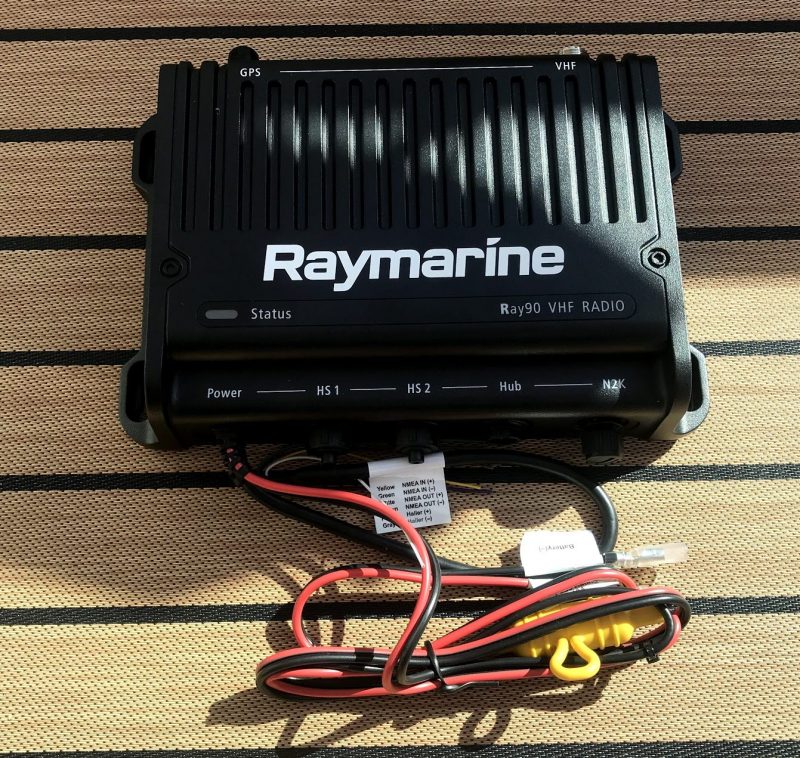



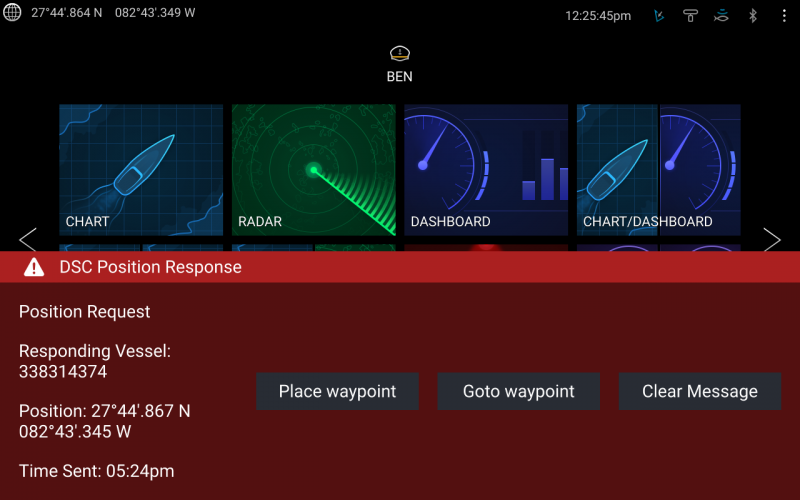






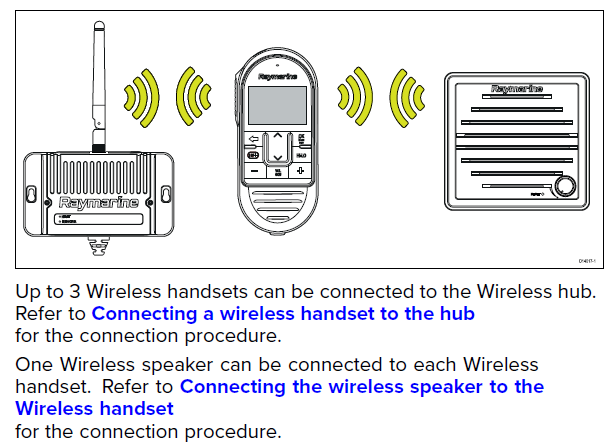













Ben – great write-up on Raymarine’s VHF – but I was hoping to see the “Last Call’ feature that Icom introduced a couple years back with their M506, which records up to two minutes of missed incoming calls and allows them to be played back again – without missing new calls. This is such a cool feature I can’t imagine why a $1,000 VHF wouldn’t offer this as well – unless Icom has it locked down tight with patent protection…. the Bluetooth stuff is maybe useful depending on how big your boat is – but the Last Call feature is something I could use just about every time I’m on the boat! Or, maybe I just need to pay closer attention… 😉
Grant, good point about immediate playback capabilities, that would be a really nice feature to have. I’m not sure if there are patent issues holding others back.
I think the biggest application for Bluetooth is likely to be those with hearing-aids or especially loud helms.
“Last Call” or “Rewind” or “Play it again” … it goes by many names, but I think I first saw automatic recording in several Cobra VHF radios (Bluetooth too) about 10 years ago:
https://panbo.com/cobra-mr-hh475-floats-rewinds-burps-does-bluetooth-cell/
The Garmin VHF 300 AIS black box system had 90 second replay, but is gone (like the Cobras) and I don’t see it in the current 315. So Icom may offer the only recreational radios with replay right now, but it’s probably not patent protected and the best I’ve seen is in Sailor VHFs because the time and channel of the recorded transmission is shown even when you’re scanning:
https://www.cobham.com/communications-and-connectivity/satcom/radio-communication-at-sea/maritime-vhf-radios/
I’m glad to see DSC + chart plotter side of things working. Even though many people never use it, it is a common question I get about integration, and it really should just work.
The angled screen thing was bothering me as I looked at your pictures – I just thought maybe there was a camera angle thing, but that would drive me insane! Especially for a premium product like this.
The Bluetooth speaker piece is also pretty cool. Very slick way to allow for remote speakers when you can’t wire a direct connection, but you do have power.
I’m very interested in your longer term testing with this system, specifically the WiFi handsets. Being pretty knowledgeable in WiFi myself, I am happy to see that Ray is using an established protocol instead of trying something new. There are a number of marine products that I have used / tested that decide to do their own thing, and the time and effort required to maintain and produce their product is impacted negatively as a result.
The only worrisome thing is the fact they chose 2.4GHz, but that is a longer range, better penetrating signal than 5Ghz, so that may end up working out for the long term.
If I needed a multi-station black box VHF, this sounds like the one to go for!
Ben E., thanks for commenting on the Last Call feature, still not sure why it isn’t more popular in some of the mainstream VHF’s from Standard Horizon, Garmin, and others… and thanks for the link to Cobham, I’d not even run across them before… seems like a quality product!
Sorry, Grant, I forgot that the Standard Horizon GX6000 I’ve been testing very recently can record 2 minutes of RX audio. Duh!
https://goo.gl/Wo4yM9
OK great Ben, thanks for that follow-up – I’m encouraged it’s not as rare a feature as I’d thought, although it still seems to be reserved for the “flagship” models for some reason – perhaps it’s expense, I don’t know. Alas, the GX6000 has about the same chunky footprint as Icom’s M506, which means it wont fit into a lot of places that were originally sized for a more traditional VHF….
And Simrad RS90
Right you are, Anon:
http://ww2.simrad-yachting.com/en-CA/Products/VHF-Radios-and-Antenna/Simrad-RS90-VHF-en-ca.aspx
I currently have a Garmin 315 Black Box VHF and it is a good radio. However I think that I will change it out for the Simrad RS90S. The RS90S has a 30 second replay but more importantly its handset has many more keys with dedicated functions as well as a numeric keypad.
The only way to change channels on the Garmin is by rotating a knob and it is many turns from 16 to 68 or 71.
For bluetooth, are they careful to close/open the channel only when receiving transmissions so as not to drain the battery say on a bluetooth wireless earpiece?
Dan, is that really a thing? I believe that Bluetooth Low Energy devices can use very little power while still available for connection but don’t think BTLE is used in headsets because it doesn’t repond quick enough (and maybe also limited bandwidth). I use all sorts of BT hearing gadgets and think they keep their amps and BT on and ready unless you tell them to “sleep” after a period of no streaming, and then it takes a bit for them to wake up.
Dan,
They’re not careful to open and close the channel, which I think makes sense given their designed use case for Bluetooth. They are assuming you’re using their speaker which is supplied with 12v power from the boat, if that’s the case the additional power use is pretty de minimis. Additionally, the time spent re-establishing the connection could be enough to cause portions of transmissions to be missed.
“The only way to change channels on the Garmin is by rotating a knob and it is many turns from 16 to 68 or 71.”
….not if you go backwards…. 😉